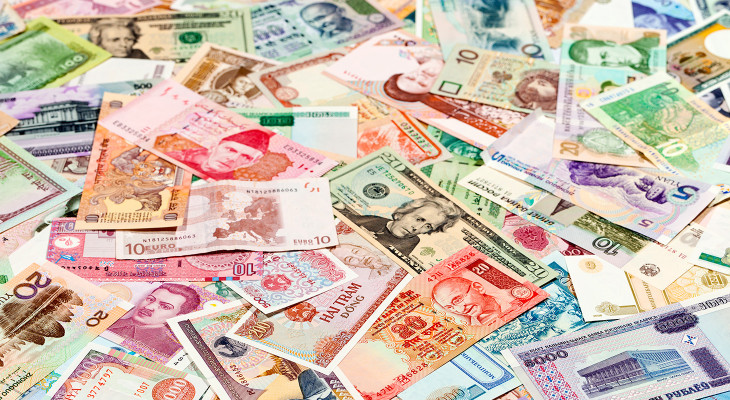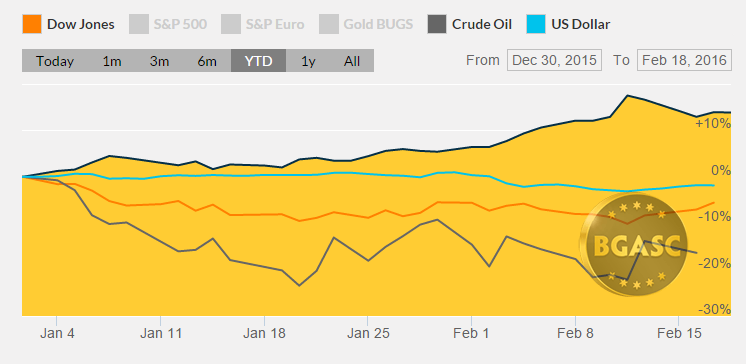
FX Friday – Global Currency Review & Forecast for 2-19-16
Extreme Volatility in the Prices of Gold, Oil and the Dollar Index
It was a wild week for all markets. Equity prices rallied three days in a row to start the week – the first time in months. Oil soared then fell, the dollar moved up with oil. Gold sold off all week then raced $30 higher on Thursday.
Week Ended February 12, 2016
The U.S. Dollar Index* closed the week ended February 12, 2016, at 95.96 on February 12, 2016. Oil closed up over 10% on Friday, the 12th to close at $28.99 a barrel. Gold finished up 5.51% on the week at $1238.50 and silver ended the week at $15.72, up 4.52% on the week.
Week Ended February 19, 2016
On Monday February 15, 2016, the U.S. markets were closed for President’s Day. Monday was an eventful day nonetheless.
The Nikkei closed up 7%, even though reports that Japan’s economy shrunk again in the fourth quarter.
The Dollar Index rose to 96.51 early morning and climbed to 96.74 by mid afternoon. Helping the dollar were comments by New York Fed President William Dudley on Friday dismissing the possibility of negative interest rates. Oil continued to build on its gains from the week before, rising to $30.04 in early morning trade on more talk about a potential OPEC production freeze.
The Russian Ruble rose with the price oil.
The Chinese Yuan rallied the most since 2005.
Goldman Sachs issued a “short gold” recommendation on President’s Day reasoning that the U.S. economy was in relatively good shape, with slight chance of entering into a recession and concluding that Fed would raise rates during the year and that fears about systemic risk were overdone. Gold fell on President’s Day when U.S. Markets were closed, sliding $30 an ounce.
The Japanese Yen also strengthened as Japan continued to spend billions to prop it up.
President of the European Central Bank, Mario Draghi spoke at the Euro Parliament and said he was ready to ease monetary policy further, driving the Euro down against the dollar.
European stocks rose 3%.
On Tuesday, the U.S. markets reopened. The Dollar Index stood at 96.65. Oil rose to well over $31 a barrel in anticipation of an announcement that Russia and Saudi Arabia might freeze or cut oil production. The Dollar Index also rose on expectations of an agreement. Russia and Saudi Arabia announced that they had come to an agreement to freeze, not cut, oil production at current levels. Oil fell back to $29.75 after the announcement.
An announcement that Azerbaijan had no plans to cut oil production dampening enthusiasm over the reported Saudi/Russian oil production freeze pact. Further pressuring oil prices was the lack of anyofficial word from Iran who is just starting to sell its oil to a wider base of customers since sanctions were lifted last month, regarding their plans to cut or freeze oil production.
Argentine and Brazilian currencies continued their slides.
U.S. Economic Data
On Wednesday U.S. new home data was released. New home starts in January fell on a seasonally adjusted basis to 1.099 million from the prior month’s 1.143 million. Expectations were for 1.173 million new hone starts.
The Producer Price Index (PPI) rose to +0.1% in January up from -0.2% last month. Expectations were for another reading a -0.2%. The Core PPI rose 0.4% up from -0.1% last month and from expectations of a flat reading.
Industrial Production came in at 0.9% ahead of expectations of 0.4%. The manufacturing component was 0.5% ahead of expecations of 0.3%. The bulk of the gain in industrial production came from a surge in Utilities of 5.4% – the largest since 2010.
Oil surged 7% on Wednesday on news that Iran had welcomed the Saudi/Russian oil output freeze.
January Federal Open Market Committee Meeting Minutes Released
On Wednesday, the minutes for the Federal Reserve’s Open Market Committee Meeting were released and showed that many Fed members saw “downside risks to the economy”. The Fed’s cautious view on the state of the economy was well known prior to the release of the minutes as rates were not raised in January and there was little expectation that the Fed would move to raise rates at its next meeting in March.
St. Louis Fed President James Bullard, who has at times vacillated from favoring rate hikes to reverting to another round of quantitative easing, remarked in a presentation to the CFA Society St. Louis on Wednesday that it would be “unwise to continue a normalization (of interest rates) strategy” at this time.
The Indian Rupee hit a near record low during the week.
On Thursday, the U.S. initial jobless claims number came in better than expected. Initial jobless claims were 262K vs an expectation of 275K. Initial jobless claims have been declining for the past three years and along with Non Farm Payroll job growth data, show, at least ostensibly, that the labor market is a bright spot in the U.S. economy.
Gold and silver surged on Thursday. Gold was up about 2% to $1235 an ounce and silver was up nearly as much at $15.51 an ounce.

Oil which had risen 14% during the past three days, fell sharply when the Saudi foreign minister Adel al-Jubeir said his country was “not prepared” to cut oil production,…If other producers want to limit or agree to a freeze in terms of additional production that may have an impact on the market but Saudi Arabia is not prepared to cut production.”
On Friday, January consumer price index (CPI) numbers were released. The CPI came in flat against expectations of -0.1% and vs. a reading of -0.1% in December. The CPI, excluding food and energy (Core CPI) rose 0.3% vs expectations of 0.2% and 0.2% reading in December. The Core CPI reading was the highest in four and a half years.
Gold sold off $7 to $1224.20 an ounce on the news and the Dollar Index rose .32% to 97.18 as a higher inflation reading increases the chance that the Fed may raise interest rates at one of their upcoming meetings. Oil also sold off 2.5% to $29.86 a barrel after the announcement.
Reports that could impact currency movements next week:
Feb 23 Case-Shiller 20-city Index
Feb 23 Consumer Confidence
Feb 23 Existing Home Sales
Feb 24 MBA Mortgage Index 02/20
Feb 24 New Home Sales Jan
Feb 24 Crude Inventories
Feb 25 Initial Claims 02/20
Feb 25 Continuing Claims 02/13
Feb 25 Durable Orders Jan –
Feb 25 Durable Goods -ex transportation
Feb 25 FHFA Housing Price Index Dec
Feb 25 Natural Gas Inventories 02/20
Feb 26 GDP – Second Estimate Q4
Feb 26 GDP Deflator – Second Estimate Q4
Feb 26 Personal Income Jan
Feb 26 Personal Spending Jan
Feb 26 Core PCE Prices Jan
Feb 26 Michigan Sentiment – Final
* The US Dollar Index tracks the US dollar vs. the Euro, the Japanese Yen, the British Pound, the Canadian Dollar, the Swedish Krona and the Swiss Franc. The Euro comprises nearly 58% of the index.
All Blog Articles are provided by a third party and do not necessarily reflect the explicit views of BGASC, nor should they be construed as financial advice.
